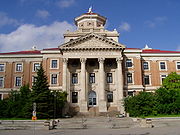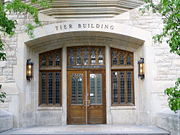University of Manitoba [매니토바 주립대학]
작성자 정보
- 푸른하늘 작성
- 작성일
컨텐츠 정보
- 18,492 조회
- 0 추천
- 목록
본문


매니토바주립대(The University of Manitoba)는 매니토바(Manitoba)주에서 가장 규모가 큰 종합대학으로 광범위한 분야의 학부와 연구를 지향하는 교육기관입니다.
○ 설립 : 1877년 (서부 캐나다의 첫번째 종합대학)
○ 캠퍼스 : 3곳에 위치 the Fort Garry Campus, the Bannatyne Campus, and the William Norrie Centre
○ Buildings and Features
The downtown Bannatyne campus of the University comprises a complex of ten buildings located west of the Health Sciences Centre between McDermot Ave and William Ave in Central Winnipeg. This complex houses the medical and dental instructional units of the University. The Faculty of Dentistry, the Faculty of Medicine, the School of Medical Rehabilitation, and the School of Dental Hygiene are the major health sciences units located on this campus. The Faculty of Pharmacy building is under construction and expected to open in 2008 in the downtown campus.
The main Fort Garry Campus is host to more than 60 major teaching and research buildings of the University and sits on 233 hectares of land.
The William Norrie Centre on Selkirk Avenue is the campus for social work education for inner-city residents.
○ Aboriginal
The University of Manitoba provides services to urban Aboriginal people. The University of Manitoba Native Studies summer course brings first-year Aboriginal students to campus before the start of the school year for some campus orientation. Aboriginal Elders are present on campus at University of Manitoba to provide social supports. Dedicated tutoring services are available within the University of Manitoba’s Medicine, Engineering and Social Work ACCESS Programs. The University of Manitoba reaches into Aboriginal communities to talk to potential students at a much younger age through Curry Biz Camp, which fosters entrepreneurship among young First Nations and Metis students.[3]
○ History
Early history
The University of Manitoba is a non-denominational university established in 1877 on Broadway, Winnipeg, Manitoba to confer degrees on students graduating from its three founding colleges - St. Boniface College Roman Catholic; St John's Anglican and Manitoba College Presbyterian. University of Manitoba granted its first degrees in 1880. [4]Consolidation was a way to strengthen these small and financially insecure institutions. Wesley College, a Methodist church college was affiliated in 1888, eleven years after the founding of University Of Manitoba. [5]
The University was the first to be established in western Canada.
From its founding until the present time, the University has added a number of colleges to its corporate and associative body. In 1882 the Manitoba Medical College, which had originally been founded by some practising physicians and surgeons, became a part of the University. Other colleges followed:
Methodist Church's Wesley College in 1888
Manitoba College of Pharmacy in 1902
Manitoba Agriculture College in 1906
St. Paul's College in 1931
Brandon College in 1938
St. Andrew's College in 1946
In 1901 the Manitoba legislature changed the University Act so that the university could do its own teaching, and in 1905 a building in downtown Winnipeg became the first teaching facility with a staff of six professors, all of whom were scientists. The governance was modelled on the provincial University of Toronto Act of 1906 which established a bicameral system of university government consisting of a senate (faculty), responsible for academic policy, and a board of governors (citizens) exercising exclusive control over financial policy and having formal authority in all other matters. The president, appointed by the board, was to provide a link between the 2 bodies and to perform institutional leadership. [5]
In the early part of this century, professional education expanded beyond the traditional fields of theology, law and medicine. Graduate training based on the German-inspired American model of specialized course work and the completion of a research thesis was introduced. [5]
The first school of architecture in western Canada was founded in 1919 at the University of Manitoba [6]
By 1920, the University of Manitoba, still the only university in Manitoba, was the largest university in the Prairie Provinces and the fifth largest in Canada. It had eight faculties: Arts, Science, Law, Medicine, Engineering, Architecture, Pharmacy, and Agriculture. It awarded the degrees of Bachelor of Arts (BA), Bachelor of Science (BSc), Bachelor of Civil Engineering (BCE), Bachelor of Electrical Engineering (BEE), Bachelor of Mechanical Engineering (BME), Bachelor of Architecture (BArch), Bachelor of Pharmacy (PhmB), Bachelor of Science in Agriculture (BSA), Bachelor of Laws (LLB), Master of Arts (MA), Master of Civil Engineering (MCE), Master of Electrical Engineering (MEE), Doctor of Medicine (MD), and Doctor of Laws (LLD). It had 1,654 male students and 359 female students, and 184 academic staff, including only 6 women.[7]
The Faculty of Law was actually an affiliated college, the Manitoba Law School, which was founded jointly by the university and the Law Society of Manitoba in 1914. In 1920 it had 123 students, including 5 women, and 21 academic staff.[7] It became a full part of the university in 1966.[8]
The University was originally located on Broadway. In 1929, following the addition of more programs, schools, and faculties, the University moved to its permanent site in Fort Garry, Manitoba. The University maintained the Broadway facilities for many years. [4]
The University established an Evening institute in 1936.
St. Andrew's College, which originally trained the ministry for the Ukrainian Orthodox Church of Canada, became an affiliated College in 1981. Furthermore, St. Andrew's College was the first Ukrainian-language college opened by the Orthodox Church in North America. It is home to a large Ukrainian cultural and religious library. St. Andrew is the patron saint of the Ukrainian Orthodox church in Canada.
The policy of university education initiated in the 1960s responded to population pressure and the belief that higher education was a key to social justice and economic productivity for individuals and for society. [5] In 1967, two of the colleges that had been part of the University of Manitoba were given university status by the provincial government. United College, which had been formed by the merging of Wesley College and Manitoba College, became the University of Winnipeg, and Brandon College became Brandon University.
St. Boniface College and St. John's College, two of the founding colleges of the University, are still part of the University of Manitoba. St. Boniface College, the Roman Catholic institution which traces its beginnings back to 1818 and the earliest days of the Red River settlement, is the University's only French-speaking college; it offers instruction in French and facilities for the training of teachers who expect to teach in the French language. St. John's College, which dates back to 1820, offers instruction in Arts and Science and, among other special programs, prepares men and women for the ordained ministry of the Anglican Church.
○ The University Today
Thirty-three of the many buildings on the Fort Garry campus of the University of Manitoba are used directly for teaching. Four of these are colleges: St. John's College, St. Paul's College, St. Andrew's College, and University College. The remaining buildings contain special laboratories, administrative and service offices, residences, or are the property of research agencies.
In a typical year, the university has an enrolment of approximately 27,000 students - 24,000 undergraduate and 3,000 graduate. The university offers 82 degrees, 51 at the undergraduate level. Most academic units offer graduate studies programs leading to master’s or doctoral degrees.
In 2005-06, the university acquired more than $120 million in research income. The university currently holds 47 Canada Research Chairs and is either home to or a partner in 36 research centres, institutes and shared facilities. These centres foster collaborative research and scholarship.
The University of Manitoba is the network leader of ISIS Canada (Intelligent Sensing for Innovative Structures), headquartered in the Faculty of Engineering. ISIS Canada is a National Network of Centres of Excellence (NCE) developing better ways to build, repair and monitor civil structures. The University is also an active member in 13 other NCEs.
○ Fight Song
Notable among a number of songs commonly played and sung at various events such as commencement and convocation, and athletic games are: 'The Brown and the Gold' (ca. 1934), with words by Charles McCulloch and music by W.J. MacDonald. [9]
○ The University, Funding, and Fees
The neutrality of this section is disputed.
Please see the discussion on the talk page. (July 2007)
Please do not remove this message until the dispute is resolved.
This section may contain original research or unverified claims.
Please improve the article by adding references. See the talk page for details. (July 2007)
The University of Manitoba had a tuition freeze imposed on it (along with all other universities in the province) by the provincial NDP government in the 1999-2000 academic year. As a result, all major funding increases have come directly from provincial government grants, and the University has been unable to continue its usual practice of reducing budgetary deficits by raising core tuition fees.
As a result, the University has undertaken a program of raising funds from student fees in alternative ways. Some of the more notable changes in tuition fee structure since the implementation of the tuition fee freeze include:
1999-2000 academic year: The Faculty of Dentistry applied for and received an exception to the tuition fee freeze, increasing their total fees for a Dentistry degree by 15%.
Spring 2002: The Faculty of Pharmacy applied for and received an exception to the tuition fee freeze, increasing their fees by $1500 every year for four years (for a total of $6000 by 2005-2006). Current students were exempted from the increase, a tactic used by the University in later years for ensuring the support of the current student body.
January 2003: The Faculty of Law held a student referendum on a tuition fee increase of $4000 over three years, an increase of 92%. Again, 'grandfathering', or exempting current students from the increase, was used to ensure student support.
November 2003: The Asper School of Business held a student referendum on increasing the per-credit-hour fee for Asper courses from $134 to $284 (a standard, full-time schedule at the University is approximately 24-30 credit hours). Due to the structure of Asper degrees, the actual cost of a degree would have increased by approximately 53.5%. However, due to active involvement of the University of Manitoba Students Union, and a broader effort by students against the increase, it was voted down by students. This defeat for the University stopped further attempts to increase fees by Faculty until the 2006-2007 academic year.
May 2004: The University Board of Governors voted to increase the recently (2002) deregulated International Student Differential Fee, which is charged to all international students, from 75% to 100% for undergraduate students. (A international student with a base tuition of $3,000 would see their international student fee increase from $2,250 to $3,000, for a total of $6,000).
June 2004: The University Board of Governors voted to increase the International Student Differential Fee, from 75% to 100% for graduate students, effective September 2005. However, they also voted to discontinue the practice of rebating the differential fee for graduate students, effectively raising graduate students' differential fee from 0% to 100%, or doubling tuition.
May 2005: The University attempted to introduce four 'ancillary fees', totaling $15.50 per credit hour. This would have increased a full-time student's tuition by about $465, but due to public and student pressure, the provincial government stepped in and limited this increase to $5 per credit hour (for a cost to a full-time student of $150). The provincial government also provided a one-time, $7-million increase to base funding for the University.
May 2006: The University attempted to re-introduce the three blocked 'ancillary fees' from the previous year, but eventually approved three flat fees of $35 (a 'registration fee'), $35 (a 'library fee'), and $30 (a 'student services fee'), for a total of $100. Some students saw this $100 increase in tuition fees, regardless of how many courses taken, as effectively penalizing part-time students. The Board of Governors also approved an increase in the International Student Differential Fee (for both undergraduate and graduate students) from 100% of base tuition to 180% of base tuition. A base tuition of $3,000 would effectively become $8,400 for international students.
March and April 2007: The Faculty of Engineering held a student referendum to raise base tuition costs from $104 to $144 per credit hour. The vote was held fairly and squarely, and was done correctly, thus Engineering students voted to increase their fees. The new fee was imposed this year on tuition
June 2007: The Board of Governors voted to implement 'laboratory fees', ranging from $25 to $30 per lab course depending on whether the lab course uses consumables or is considered a 'language lab' (e.g., Spanish, French, et cetera). Full-time Science students could see their fees increase by $120-150 per year.
○ Academics
University of Manitoba St Boniface College
University of Manitoba St Pauls College
University of Manitoba St Johns College
University of Manitoba St Andrews College
The University of Manitoba had a total enrollment of approximately 28,000 students (post-grad med: 1.8%, distance: 3.5%, grad: 12%, undergrad: 83%), in 22 faculties. Most academic units offer graduate studies programs leading to master’s or doctoral degrees.
The university is represented in Canadian Interuniversity Sport by the Manitoba Bisons.
The current colleges are:
College universitaire de Saint-Boniface (University College of St. Boniface)
St. John's College
St. Paul's College
St. Andrew's College
University College
The university's faculties:
Agricultural and Food Sciences
School of Agriculture
Architecture
School of Art
Faculty of Arts
Clayton H. Riddell Faculty of Environment, Earth, and Resources
Faculty of Dentistry
School of Dental Hygiene
Faculty of Education
Faculty of Engineering Students can choose to specialize in the following disciplines: Biosystems Engineering, Civil Engineering, Computer Engineering, Electrical Engineering, Industrial Engineering, Manufacturing Engineering and Mechanical Engineering [10]
Extended Education
Faculty of Human Ecology
Faculty of Human Ecology: Department of Human Nutritional Sciences has an accredited dietetic program. The university is accredited by a professional organization such as the Dietitians of Canada and the university's graduates may subsequently become registered dietitians. List of universities with accredited dietetic programs
I. H. Asper School of Business
Faculty of Law
Marcel A. Desautels Faculty of Music
School of Medical Rehabilitation
Faculty of Medicine
Faculty of Nursing
Faculty of Pharmacy
Faculty of Kinesiology & Recreation Management
Faculty of Science
Faculty of Social Work
Division of Extended Education
University 1
○ Libraries (Alphabetically)
The University of Manitoba has 19 libraries:
Albert D. Cohen Management Library
Architecture/Fine Arts Library
Bill Larson Library (Grace General Hospital)
Carolyn Sifton-Helene Fuld Library (St. Boniface General Hospital)
Concordia Hospital Library
Donald W. Craik Engineering Library
Eckhardt Gramatte Music Library
E.K. Williams Law Library
Elizabeth Dafoe Library
Father Harold Drake Library (St. Paul's College)
J.W. Crane Memorial Library (Deer Lodge Centre)
Misericordia Health Centre Library
Neil John Maclean Health Sciences Library
Riverview Health Centre Virtual Library
St. John's College Library
Sciences and Technology Library
Seven Oaks General Hospital Library
Victoria General Hospital Library
William R. Newman Library
<출처 : Wikipedia.com>


























